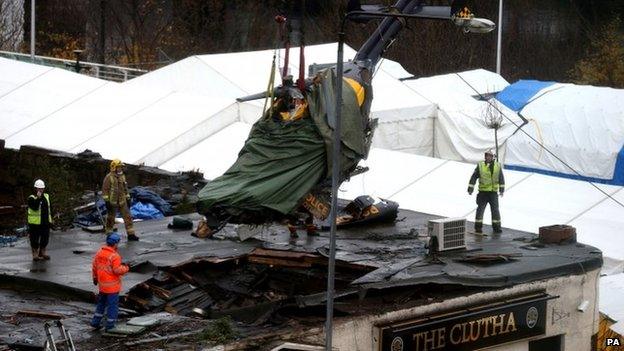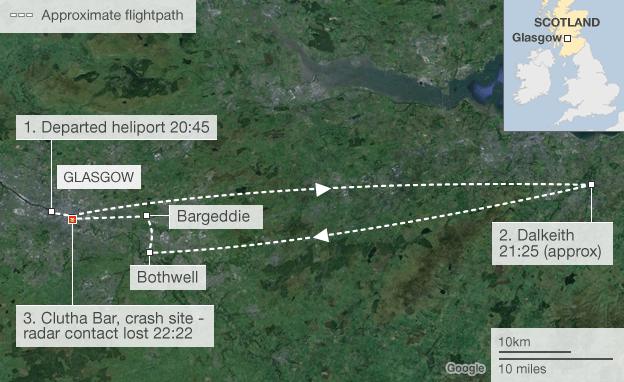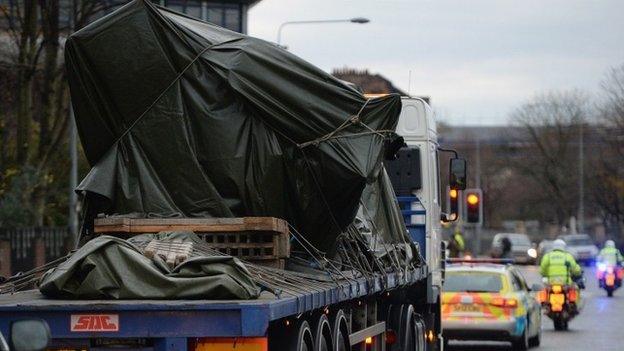Clutha helicopter crash: AAIB finds 'no evidence' of mechanical fault
- Published

Nine people died after the helicopter crashed into the busy pub
Investigators have found no evidence of a "major" engine or gearbox failure in the police helicopter which crashed into a busy Glasgow pub.
Preliminary findings from the Air Accidents Investigation Branch, external (AAIB) found the main and tail rotors were not rotating at the time of impact.
The report also stated the Police Scotland helicopter had about 95 litres of fuel when it crashed on The Clutha.
The three crew and six people in the bar died in the crash on 29 November.
The BBC's Kevin Keane said the helicopter had 95 litres of fuel when it crashed
The report said that the helicopter took off at 20:45 with 400kg of fuel on board.
Radar contact lost
It stayed over an area of Glasgow's south side for about 30 minutes before making a short 10 minute foray over Dalkeith in Midlothian, some 38 nautical miles away.
The helicopter was granted permission to re-enter Glasgow air space at 22:18.
The report said: "No further radio transmissions from the pilot were received. Radar contact with the helicopter was lost at 22:22."
Around this time the helicopter was seen and heard by a witness who described hearing a noise like a loud "misfiring car".
The report continued: "He then saw the helicopter descend rapidly. It crashed through the roof of The Clutha Bar, a single storey building on Stockwell Street in central Glasgow."
In its preliminary engineering investigation, the AAIB report said: "The initial evidence indicated that the helicopter struck the flat roof of the single storey building with a high rate of descent and low/negligible forward speed.
"Preliminary examination showed that all the main rotor blades were attached at the time of the impact but that neither the main rotor nor the fenestron tail rotor were rotating."
The report said the helicopter suffered "very extensive damage" during impact but remained "approximately upright".
The AAIB said it managed to conduct a preliminary examination of the wreckage within The Clutha but "the state of the building limited the extent to which examination of the helicopter was possible in situ".
Once the helicopter had been removed from the building, the AAIB said that "approximately 95 litres of fuel were drained from the fuel tank system".
It said that initial examinations at the scene and later analysis of the wreckage at the AAIB's headquarters in Farnborough, Hampshire, "confirmed that all significant components were present at the time of impact".
The report continued: "Initial assessment provided no evidence of major mechanical disruption of either engine and indicated that the main rotor gearbox was capable of providing drive from the No 2 engine power turbine to the main rotor and to the fenestron drive shaft.

The helicopter was returning to Glasgow from Dalkeith in Midlothian when it crashed
"Clear impact distortion of the structure had caused a splined shaft on the drive train from No 1 engine to disengage, preventing a similar continuity check."
The report added: "Detailed examination of the helicopter continues."
The Eurocopter EC135 T2 was not required to have, and did not have, flight recorders, the report noted.
It does say, however, that some systems on board the aircraft record fault codes and these, along with others that record images and audio, "will be examined and analysed".
The report said: "Radar data covering the helicopter flight has been recovered.
Communications analysed
"That and radio communications are also being analysed and closed-circuit television recordings will be reviewed."
The report ends by stating: "The AAIB investigation will continue to examine all the operational aspects of this accident and conduct a detailed engineering investigation of the helicopter.

(Top row left to right) David Traill (pilot), PC Kirsty Nelis, PC Tony Collins; (Middle) Gary Arthur, Samuel McGhee, John McGarrigle; (Bottom) Colin Gibson, Mark O'Prey, Robert Jenkins all died in the crash
"The AAIB will report any significant developments as the investigation progresses."
Aviation analyst Sean Maffett told BBC Radio Scotland the initial report appeared to rule out a number of causes for the crash.
He said the helicopter did not run out of fuel as there were 95 litres on board when it crashed, which would have given it 15 to 20 minutes flying time.
The report said that neither the main rotor nor the fenestron rotor at the back were "rotating at the time of impact".
Mr Maffett said: "What they don't say, and what is probably very significant, is how long before that they might have been rotating."
'Big mystery'
He said the report suggested that nothing had dropped off the aircraft, both engines seem to have been working, and the gearbox was capable of providing drive to the rotors from the number two engine.
"The thing about all of this is it leaves us with a pretty big mystery as to what actually did go wrong," he said.

The helicopter wreckage is being examined at the AAIB base in Farnborough, Hampshire
Mr Maffett added: "Quite often these inquiries can take a year. They don't have some of the things that could have made it quicker such as the so-called black boxes cockpit voice recorder and flight data recorder.
"They do have some electronic information from in the aircraft but they have not given any indication what might be in it."
Patrick McGuire, from Thompsons solicitors, which is representing some of the families affected by the crash, commended the AAIB for the speed with which it had produced its interim report.
"But many questions are still to be answered and the families of those killed and injured in this awful tragedy need to know what happened as quickly as possible," he said.
"All the families involved will hope and expect that they are kept fully informed by the authorities about the progress of the different investigations that are taking place."